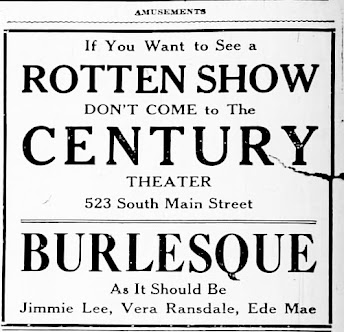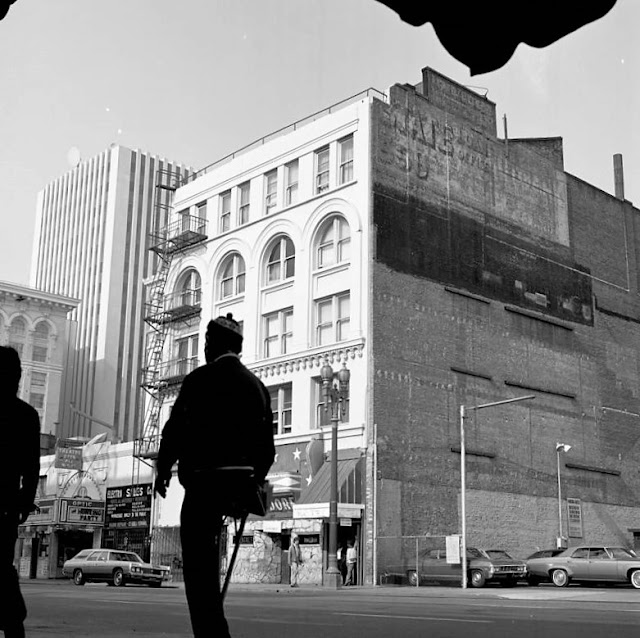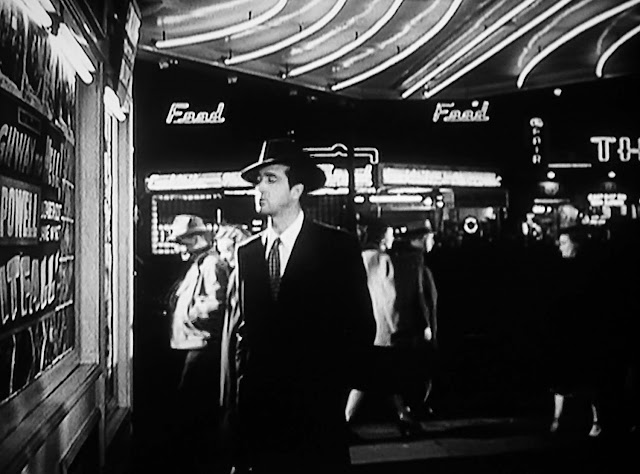Opened: This venue of many names opened as the Novelty Theatre on October 23, 1905. It was on the west side of the street a bit south of 5th. It was in a three story building that was initially called the Interlaken Hotel building, at the end called the Waldorf Hotel. The building was a project of H. J. Woolacott, who erected it at at a cost of $46,000.
The theatre was initially operated by Theo Rothschild and Samuel Loverich with Leon Levy as the manager. Loverich was also involved with the Novelty Theatre in San Francisco.
Architect: Robert Brown Young. Thanks to eminent L.A. historian Nathan Marsak for finding the construction photo in "The
Architecture of Robert Brown Young," a book in the Los Angeles Public
Library's rare books collection that was published in 1905 by J.L. Le
Berthon. In addition to the photo, the theatre is mentioned in a short biography of Young that's in
the book. It's reproduced at the bottom of the page about the Empire Theatre, another Young design.
It was a busy block. Just south of what ended up as the Gayety Theatre were the Star Theatre and
the Optic. Down at
the end of the block, also on the west side, were the Picture Theatre at 545 (until 1926), the Art at 551 and the Bijou (until 1914) at 553. On the east side of the street were the Rounder at 510 (around in 1910), the Galway at 514, the Sherman at 518 (running until 1919) and the Burbank at 548.
Stage Specifications: The 1907-08 edition of Henry's Official Western Theatrical Guide lists the theatre as the Peoples and offers some data: Proscenium: 27' 10" wide x
20' 4" high Stage depth: 20' Grid height: 42'10" Stage wall to wall:
40' Illumination: both gas and electricity. The publication is on Google Books.
The Novelty can be seen in this detail from image 6 of Volume 2 of the 1906 Sanborn Fire Insurance Map that's on the Library of Congress website.
By the time the 1906 city directory was compiled it was called the People's Theatre. In the fall of 1906 it was being advertised as the New People's.
A 1907 L.A. Times ad for the theatre as the People's. Thanks to Ken McIntyre for posting it on the Photos of Los Angeles private Facebook group.
Frank Haggerty is listed as manager in the 1907-1908 Henry's Guide. It was known as the the Peoples through about 1909. The September 24, 1909 issue of the L.A. Times, in an article located by Jeff Bridges headlined "Record Deal On Main," reported that the building had been sold to John C. Mordough for $225,000:
"Foreign Capitalist Pays Nearly a Quarter Million for Peoples' Theater Site - One of the largest and most important deals in Los Angeles business property consummated this year was put through yesterday when John C. Mordough, a retired banker and lumber merchant, of the City of Mexico, purchased through the agency of R.A. Rowan & Co., the property at Nos. 521-523-525 South Main street, known as the Peoples Theater building. H.J. Woolacott, the seller, received $225,000 for his holding, or at the rate of over $3500 a front foot. The site is improved with a three-story brick building, containing two stores and the Peoples Theater on the ground floor, and a rooming-house on the two upper floors.
"Flushed by the success of his preceding ventures, Mr. Quinn later added a third moving picture theater to his list. This house is located on Main St., and as soon as he had closed a seven year lease on the property with Loewen Brothers the painters and decorators were working 'like mad' in order to get the house ready on time. To the facade of the house, 2,500 additional electric lights were added. This house was opened under the name of the Century. Mr. Quinn soon made this theatre one of the dominant attractions on Main Street. Feature pictures form the entertainment."
See the page on Quinn's Superba for more about J.A. Quinn and his other theatre adventures. Quinn didn't keep the theatre even until mid-1914. And Alphin was back again, having renamed the house the Alphin Theatre. An April 8, 1914 L.A. Times item located by Jeff Bridges noted:
This detail from plate 002 of the 1914 Real Estate Survey from Historic Map Works shows the Optic at 533, the Portola/Star at 529 in the Green Hotel Building, and the Century/Gayety at 523 in the Interlaken Hotel Bldg.
Thanks to Ken McIntyre for locating the article.
"Fire of
unknown origin threatened the entire structure which houses the Omar
Theater at No 523 South Main street, early yesterday morning. The blaze
started in the back of the theater stage and had caused an estimated
damage of $500 before it could be mastered by the fire department."
The theatre remained the Omar until May 1922 when it was leased to the Gore Brothers and became the Moon Theatre. It's listed as the Moon in "Paramount Week" ads that ran in the September 2, 1923 and August 31, 1924 issues of the Times.
Gayety operator Robert Levy was in trouble in 1937. Thanks to Jeff
Bridges for finding this May 9 L.A. Times article headlined "Lobby
Pictures Land Three Theater Owners In Jail." The other theatres
mentioned were the Rosslyn Theatre at 431 S. Main and the Lark Theatre at 613 S. Main. The news:
"Last night a collection of lithographs showing rotund young women in Gypsy Rose Lee postures but with less habiliments than La Lee customarily wears, lay scattered in a squad room of Central Police Station. The officers there were yawning or reading detective stories. And in the City Jail were three proprietors of Main street burlesque and honky-tonk shows, charged with suspicion of violation of the law governing lewd and indecent display of pictures in theater lobbies.
"The three are Harold Richards, 35 years of age, proprietor of a
theater at 431 South Main street; Robert Levy, 21, showman of 523 South
Main street, and John Revis, 23, 613 South Main street. The showmen,
according to Detective Lieutenant C.M. Buxton, in charge of the vice
squad detail raiding the theaters, refused to heed a police warning
against displaying the posters. The lithographs over which the officers
at Central Station yawned were confiscated in the raid."
Closing: Sometime in the mid-1950s. In the 1956 phone book and the 1960 city directory, the Waldorf Hotel is still there, but there are no listings for the Gayety anymore.
Status: The building was demolished sometime prior to 1963. The area where the building was became a temporary Main St. MTA bus station from 1963 until 1967. A parking garage is now on the site.
c.1907 - Looking north along the west side of the 500 block. The Brennan Hotel building that would later house the Portola/Star Theatre is the one with "G.A. Theil Wallpaper" sign on the side. The Peoples Theatre is just beyond. In the upper left note the Alexandria Hotel on the southwest corner of 5th and Spring. The steel going up is for the Security Building on the southeast corner of 5th and Spring. It's a California Historical Society photo on the USC Digital Library website.
c.1907 - A detail from the USC photo.
1907 - Another view showing the Peoples Theatre. We're looking northwest from the Pacific Electric Building. It's a C.C. Pierce photo from the California Historical Society appearing on the USC Digital Library website where they date it as c. January 1, 1907. Note the Morosco's Burbank Theatre signage at the bottom of the photo.
1907 - A detail from the photo above. Note the swing-out sign for the Peoples.
1911 - A view by G. Haven Bishop looking south from just above 5th & Main. It's a photo taken for Southern California Edison that's in the Huntington Library collection.
1911 - A detail from the G. Haven Bishop photo. That first "Colyear's" vertical is for a furniture store. Beyond, we have signage for what had been the Peoples, here called the Olympic Theatre. Beyond that, there's the "Vaudeville" vertical and the illuminated arched entrance of the Optic. It's a photo taken for Southern California Edison that's in the Huntington Library collection.
1913 - A January photo from the Los Angeles Fire Department Historical Archive. At the left is the Optic Theatre, with its vertical sign mounted on the much taller Brennan hotel building in the center. The Los Angeles Paint and Wallpaper Co. at 529 S. Main in the Brennan building helped feed the fire. Later that space would be home to the Star Theatre. On the right what had been the Olympic, here has been renamed the Century Theatre.
For more coverage on the LAFire site go to the Major Incident page and look for "Brennan Hotel Fire, 1913" in the index on the left column. On the Brennan page, click on "see completion LAFD photo album photo collection" under the photo for more views.
1914 - "Quinn's Big Show" at the Century. It's a photo from the Moving Picture World issue of March 28, 1914. It's on Google Books.
c.1916 - A Martin Behrman photo in the California State Library collection. Note the top of the "Burlesque" and "Century" vertical signs in the lower left. The Library dates this as c.1922 but it has to be earlier.
c.1917 - A California Historical Society photo looking north showing the Optic sign on what has beecome the Hotel Green. The Optic and the Portola/Star entrances are out of the frame in the lower left. The "Burlesque" vertical and two more beyond are for the future Gayety Theatre, here called the Omar. Note the new Rosslyn Hotel Building on the northwest corner of 5th and Main. The photo is on the USC Digital Library website. It's also in the Los Angeles Public Library collection where they credit it to C.C. Pierce. USC also has another similar 1917 view evidently taken at the same time.
c.1938 - "Girls For Sale" was a film that dated from 1931. Thanks to Sean Ault for finding the photo for sale online.
c.1938 - "Sex Maniac," aka "Maniac," was released in 1934. Thanks to Ken McIntyre for finding the photo for a post on the Photos of Los Angeles Facebook page.
1939 - A great Dick Whittington photo showing the west side of the block as we look north toward 5th St. The photo is in the USC Digital Library collection.
1939 - A last look at the rectangular Gayety marquee before it succumbed to the new fashion of going for the chopped-off angled look. It's a detail from the Dick Whittington photo. Note that they've tried to cover the vertical. It still says "Moon" at the top and "Vaudeville" down the length.
c.1946 - A detail from the photo above. Thanks to Nathan Marsak for this version of the image. On the marquee: "Humphrey Bogart - Lauren Bacall - Keenan Wynn."
1946 - A fine shot looking north on Main with the Star in front of us. The Gayety is down the block with James Cagney, Merle Oberon and William Boyd on the marquee. Not all in the same feature, of course. It's the Truancy Detail in action. It's a Los Angeles Daily News photo appearing on the UCLA Digital Library website. Thanks to Eitan Alexander finding the photo in the UCLA collection. The Daily News caption:
"Woman talks to boys skipping school outside a movie theater in downtown Los Angeles. The truancy problem prompted the 10th District Congress of Parents and Teachers to recommend an expansion of the truancy detail, which would include increasing personnel in outlying portions of the district as well as on beaches."
1947 - Behind the rear of the streetcar we see the top of the facade of the Optic. The marquee of the Gayety is visible down the block. Thanks to Ken McIntyre for finding the photo for a post on the Photos of Los Angeles private Facebook group.
c.1948 - A bit of the Gayety on the left along with a car on the Pacific Electric Watts line. Note the "Hotel" signs on the doorway just to the right of the marquee for the Waldorf Hotel upstairs in the same building as the theatre. It's a Los Angeles Public Library photo.
1963 - A view south toward the Optic as a LAMTA officer holds back the pedestrians. The bus and driveway are where the Gayety had once been. The area was being used as a temporary Main St. bus station. The Dover Hotel building housed the Star Theatre. Thanks to Sean Ault for the photo. It had appeared in the October 1963 issue of the MTA Emblem that's in his collection.
c.1972 - The lot on the right is where the Gayety's building had been. The Star's entrance was once in the center building, here seen with signage down and a gate across the entrance. On the left, the Optic is still in business with "The Hunting Party," a 1971 release with Oliver Reed, Candace Bergen and Gene Hackman on the marquee. It's Victor Plukas photo in the Los Angeles Public Library collection.
1973 - Looking north toward 5th with the buildings for the Optic and the Star on the left. The space beyond is where the Gayety had been. The Burbank, on the right, would be demolished in 1974. It's a photo by Victor Plukas in the Los Angeles Public Library collection.
The Gayety in the Movies:
We're under the marquee of the Gayety in "The
Crooked Way" (United Artists, 1949). John Payne is a veteran suffering
from amnesia who comes to Los Angeles to try to get some clues about his
forgotten life. He's learning he was a gangster and some of his
previous associates (and an ex-wife) aren't too happy to see him again.
The Optic and the Gayety (with a bit of the Star in between them) are
seen on the left at 8:22 into nearly 11 minutes of 1950 footage intended
for use as process shot
backgrounds in film or TV shows. A lovely colorized and remastered
version is on YouTube
from NASS as "1950s - Views of Los Angeles in color..." The original footage is on Internet Archive as Pet 1067 R 4.
On Main St. we also get views of the Muse, Burbank,
Regent, Follies, Hippodrome and Liberty theatres. 7th St. footage includes the Warner
and Loew's State.
The opening credit sequence of "Farewell, My Lovely" (Avco Embassy, 1975) features stylized footage of Hollywood landmarks and then, just for variety, we get this bit of c.1940 clip of Main St. The cafe on the left at 527 S. Main was in the Green Hotel building, also housing the Star Theatre at 529. In the center it's a pawn shop at 525. The Gayety, at 523, is on the right. The film is an adaption of Raymond Chandler's 1940 novel. Moose Malloy, just out of prison, is looking for his former girlfriend Velma Valento, who for several reasons doesn't want to be located.
Jack O'Halloran is Moose. Robert Mitchum plays private eye Philip Marlow. Also involved are John Ireland, Charlotte Rampling, Sylvia Miles, Harry Dean Stanton, Anthony Zerbe, Sylvester Stallone and Kate Murtagh. Dick Richards directed. The cinematography was by the "King of Noir," John A. Alonzo. See the Historic L.A. Theatres in Movies post for shots of various Hollywood theatres seen in the title sequence including the Earl Carroll, the Hollywood, the Warner and the Iris.
See the page here on this site about another Novelty Theatre at 136 S. Main St. Also see information about a later Olympic Theatre on 8th St. just west of Broadway.
Check out a lovely 1950s downtown map
that shows many theatre locations including the Gayety.
It's from a now-vanished website by Tom Wetzel about the history of L.A.
transit.
| back to top | Downtown: theatre district overview | Hill St. and farther west | Broadway theatres | Spring St. theatres | Main St. and farther east | downtown theatres by address | downtown theatres alphabetical list |
| Westside | Hollywood | Westwood and Brentwood | Along the Coast | [more] Los Angeles movie palaces | the main alphabetical list | theatre history resources | film and theatre tech resources | theatres in movies | LA Theatres on facebook | contact info | welcome and site navigation guide |

















































No comments:
Post a Comment